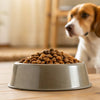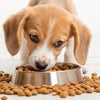Why Has My Dog Stopped Eating His Dry Food? Understanding the Reasons and Solutions
- Houndsy
Table of Contents
- Introduction
- Common Reasons for Loss of Appetite
- What to Do When Your Dog Stops Eating
- The Role of Feeding Rituals
- When to Seek Further Help
- Conclusion
Introduction
As devoted pet owners, we often find ourselves puzzled and concerned when our furry friends suddenly refuse to eat their meals. According to recent studies, approximately 20% of dog owners report their pets experiencing occasional loss of appetite. This statistic highlights a common challenge that many of us face: the unsettling moment when we ask ourselves, "Why has my dog stopped eating his dry food?" Understanding the reasons behind this behavior is essential for ensuring our pets' health and happiness.
In this blog post, we will delve into the various factors that can contribute to a dog's reluctance to eat dry food. We’ll explore medical, behavioral, and environmental influences that may be at play. Our goal is to provide you with actionable insights to help you navigate this concern effectively, ensuring your dog remains happy, healthy, and well-fed.
We’ll cover a wide range of topics, including potential health issues, changes in routine, the impact of feeding habits, and ways to make mealtime more appealing for your dog. By the end of this article, you will have a better understanding of why your dog may have stopped eating his dry food and what you can do to encourage him to eat again. Let’s embark on this journey together and find the answers that will help us create a more enjoyable feeding experience for our beloved pets.
Common Reasons for Loss of Appetite
Medical Issues
One of the most critical factors to consider when our dogs stop eating is their health. A sudden change in appetite can be a warning sign that something may be wrong. Here are some common medical issues that can lead to a decrease in appetite:
- Dental Problems: Dogs can experience tooth decay, gum disease, or other dental issues that make eating painful. If your dog is showing signs of discomfort while eating, it might be time for a veterinary check-up.
- Gastrointestinal Issues: Conditions such as gastritis, pancreatitis, or intestinal parasites can lead to nausea and discomfort. These issues often manifest as a reluctance to eat, along with other symptoms like vomiting or diarrhea.
- Chronic Illnesses: More serious health conditions, such as kidney disease, liver disease, or cancer, can significantly affect a dog's appetite. If your dog is exhibiting other concerning symptoms, seeking veterinary assistance is crucial.
- Medication Side Effects: If your dog is on medication, it might be worth investigating whether a change in appetite is a side effect. Some medications can cause nausea or alter taste preferences.
Behavioral Factors
Beyond medical reasons, behavioral issues can also play a significant role in a dog's eating habits. Here are some behavioral factors that might influence your dog’s appetite:
- Stress and Anxiety: Dogs are sensitive creatures, and changes in their environment can lead to stress. Changes like moving to a new home, the arrival of a new family member, or loud noises (like fireworks) can cause anxiety, affecting their willingness to eat.
- Routine Disruption: Dogs thrive on routine. If their feeding schedule is inconsistent or if their food bowl is moved to a different location, they may refuse to eat. Maintaining a consistent feeding routine is vital for dogs.
- Boredom with Food: Just like us, dogs can become bored with their meals. If you’ve been feeding the same dry food for an extended period, your dog may simply be looking for some variety.
Environmental Influences
The environment where your dog eats can also impact their eating habits. Consider the following factors:
- Feeding Area: If your dog’s food bowl is placed in a busy or noisy area, it may deter them from eating. Dogs prefer a calm and quiet space where they feel safe while they eat.
- Bowl Design: The design and placement of the food bowl can affect how your dog eats. Slippery bowls may move around while eating, causing frustration. Our Houndsy Kibble Dispenser is crafted with an ergonomic design that ensures stability, making it easier for your dog to eat comfortably.
What to Do When Your Dog Stops Eating
When faced with the challenge of a dog refusing to eat, it’s important not to panic. Here are steps we can take to help our dogs resume their normal eating habits:
Monitor Their Behavior
The first step is to observe your dog closely. Take note of any accompanying symptoms, such as lethargy, vomiting, or diarrhea. This information will be invaluable when consulting with a veterinarian.
Consult Your Veterinarian
If your dog’s refusal to eat persists for more than a day or two, it’s essential to reach out to your veterinarian. They can assess your pet's health, run necessary tests, and provide a diagnosis.
Consider Food Options
Sometimes, the food itself can be the culprit. Here are strategies to make meals more enticing:
- Mix in Wet Food: Adding a small amount of wet food to dry kibble can enhance flavor and aroma, making it more appealing.
- Warm Up the Food: Gently warming your dog’s food can release enticing aromas, which may stimulate their appetite.
- Switch Up the Brand: If your dog has grown tired of their current kibble, it might be time to try a different brand or flavor. Ensure any switch is gradual to prevent digestive upset.
Create a Calm Eating Environment
To foster a more inviting eating experience, we can create a calm and quiet space for our dogs. Avoid distractions and ensure the feeding area is comfortable and accessible.
Reinforce Positive Associations
Encourage your dog to eat by using positive reinforcement. Praise them when they approach their food or take a few bites. If they eat well, consider rewarding them with a treat or extra playtime afterward.
The Role of Feeding Rituals
Feeding time is not just about nutrition; it’s also a bonding experience between us and our pets. Establishing a feeding ritual can enhance this connection and encourage our dogs to eat. Here are some tips:
- Consistent Schedule: Feed your dog at the same times every day to create a routine they can rely on. This consistency can reduce anxiety and make mealtime something they look forward to.
- Engaging Mealtime Activities: Consider using interactive feeding toys or puzzles that make your dog work for their food. This can stimulate their mind and turn eating into a fun activity.
When to Seek Further Help
While many dogs may go through phases of decreased appetite, there are times when it becomes critical to seek further help. If your dog exhibits any of the following signs, it’s time to consult with a veterinarian:
- Persistent refusal to eat for more than 48 hours
- Weight loss or noticeable changes in body condition
- Lethargy or lack of energy
- Vomiting, diarrhea, or any other concerning gastrointestinal symptoms
- Changes in behavior or increased signs of stress
Conclusion
Understanding why our dogs may stop eating their dry food can be a complex journey that involves considering medical, behavioral, and environmental factors. By monitoring their behavior, consulting with veterinarians when necessary, and creating a positive feeding environment, we can encourage our pets to return to their normal eating habits.
As we work to enhance our dogs' feeding experiences, we also have the opportunity to deepen our bond with them. Remember, providing the right tools can make a significant difference. Our Houndsy Kibble Dispenser not only simplifies the feeding process but also ensures that mealtime remains a joyful ritual for both you and your dog.
If you’re looking for a way to elevate your dog’s feeding experience, explore our Houndsy Kibble Dispenser today. Let’s make mealtime a delightful experience that nourishes both body and soul!
FAQ
Q: My dog has stopped eating his dry food but is still drinking water. Should I be concerned?
A: While it’s encouraging that your dog is still drinking water, a sudden change in appetite can still warrant attention. Monitor for any additional symptoms and consult your veterinarian if the issue persists for more than a day or two.
Q: What should I do if my dog only eats when I hand-feed him?
A: Hand-feeding can indicate your dog prefers a more engaging eating experience. Try to create a calm atmosphere at mealtime or consider using interactive feeding toys to encourage him to eat from his bowl.
Q: How can I tell if my dog is sick or just being picky?
A: If your dog is showing other symptoms—such as lethargy, vomiting, or diarrhea—it’s essential to consult your veterinarian. If they’re otherwise healthy but simply refusing dry food, they may just be bored or prefer another type of food.
Q: Can I mix different types of food together?
A: Yes, mixing dry food with wet food or adding broth can make meals more appealing. Just remember to transition gradually to avoid digestive upset.
Q: What are some signs of dental problems in dogs?
A: Signs include difficulty eating, bad breath, pawing at the mouth, and excessive drooling. If you notice these symptoms, it's vital to consult your veterinarian for an examination.












